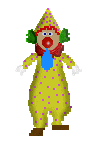Several volunteer chewers
A balance that will weight to the nearest tenth of a gram
A pen or pencil
A piece of paper

| Acknowledgement |
| Supplies Needed | |
|---|---|
| Several pieces of nickel bubble
gum Several volunteer chewers A balance that will weight to the nearest tenth of a gram A pen or pencil A piece of paper |

|
Folks have been chewing gum-like stuff for centuries. Resins and latex from trees, grasses, waxes, you name it. Greeks chewed mastic gum made from the resin of the shrub-like mastic tree common to Greece and Turkey. North American Indians introduced colonists to spruce gum, made from resin that oozed from spruce tree when it's bark was cut. Spruce gum chunks were sold in the early 1800's in northeastern U.S. In the middle of the 1800's, paraffin wax with sweetner added, surpassed spruce gum in popularity.
At this point in time, General Santa Anna, infamous leader of the Mexican army that wiped out the Alamo, enters the story. Sometime after this historic battle, Santa Anna visited New York. He had with him a large amount of sapodilla tree sap. Sapodilla trees are quite common in rainforests found in Mexico, Central, and Southern American, and natives had been chewing on this stuff for many years. Santa Anna wasn't really into the chewing side, but hoped to find someone who could take the chicle that came from the milky latex juice of the sapodilla trees and refine it and make a cheap rubber substitute. He approached Thomas Adams. This inventor tried many things with the chicle and finally threw a chunk in his trash. Legend has it his young son crawled by the trash, picked up the chunk, and promptly placed it in his mouth to check it out further. Lucky for gum lovers, Adams realized the potential as he reached his son and tried to remove the mass from his mouth. It took Thomas Adams about a year to bring his discovery to market. He named it:
Today's gums are modern day manufacturing marvels. Thanks to modern science, it's no longer necessary to sacrafice trees so gum lovers can chew, smack, snap, and blow bubbles.
Most students think the mass will increase on chewing. The mass should have decreased dramatically. Over 60% of the bubble gum will be sugar that has dissolved in the saliva in the student's mouth and been swallowed. Check the nutrition label on the large container that has the nickel bubble gum in it, or on the bag if you buy the gum in large quantities. Typical pieces will have mass of 5 to 7 grams with 3 to 5 grams reported for mass of sugar. Compare you results.
Full Disclaimer PSLC OFFERS THIS SITE AS AN EDUCATIONAL TOOL. PSLC IS NOT RESPONSIBLE FOR ANY INJURY OR DAMAGE CAUSED TO ANY PERSON, DIRECTLY OR INDIRECTLY, RELATING TO ANY OF THE DEMOS OR EXPERIMENTS LISTED AT THIS SITE. YOU ARE WHOLLY RESPONSIBLE FOR YOUR SAFETY. |